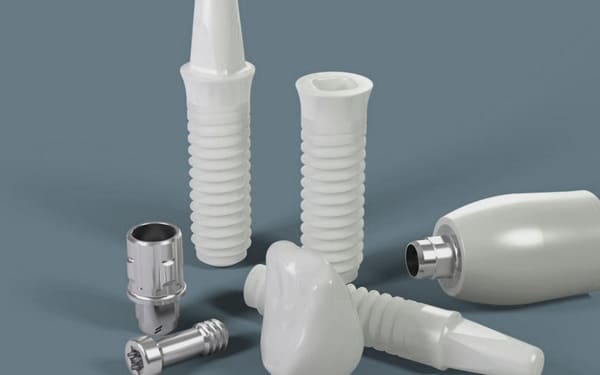Why Choose Zirconium Oxide Implants?
Dental implants have revolutionized restorative dentistry, offering a durable and functional solution for missing teeth. Traditionally, titanium has been the gold standard for implants due to its strength and reliability. However, zirconium oxide, a ceramic material, has emerged as a compelling alternative, gaining popularity for its unique properties. This blog examines why zirconium oxide implants are increasingly favored by patients and dental professionals alike, highlighting their benefits, comparing them with other materials, and considering the suitability for potential candidates.
At Advanced Ceramics Hub, we specialize in high-quality zirconium oxide ceramic products, manufactured in various forms and specifications, to ensure optimal performance for industrial and scientific applications.

What Are Zirconium Oxide Implants?
Zirconium oxide, also known as zirconia, is a high-performance ceramic material used in dental implants. Unlike traditional metal-based implants, zirconia is metal-free, making it an excellent choice for patients seeking biocompatible and aesthetically pleasing options. Zirconia implants are crafted from a crystalline form of zirconium dioxide, which is processed to achieve exceptional strength and durability. These implants are typically designed as one-piece systems, integrating the implant and abutment, which simplifies the surgical process and enhances stability.
1. Material Properties of Zirconium Oxide (ZrO2) Implants
| Property | Zirconia (ZrO₂) | Comparison to Titanium |
| Biocompatibility | Hypoallergenic, no metal ions released | Titanium may cause allergic reactions in rare cases |
| Strength | 900–1200 MPa flexural strength | Stronger than titanium (500–800 MPa) |
| Fracture Toughness | 5–10 MPa·m¹/² | Lower than titanium but sufficient for dental/orthopedic use |
| Aesthetics | Tooth-colored (white) | Titanium is metallic gray (less aesthetic) |
| Corrosion Resistance | Immune to body fluids | Titanium resists corrosion but can oxidize long-term |
2. Key Characteristics
- Metal-free composition.
- High biocompatibility with human tissues.
- White, tooth-like color for natural aesthetics.
3. Types of Zirconia Implants
A. Dental Implants
Monolithic Zirconia:
- Single-piece design, no metal components.
- Used for crowns, bridges, and full-arch restorations.
Hybrid Zirconia:
- Zirconia abutment + titanium screw (combines strength and aesthetics).
B. Orthopedic Implants
- Femoral Heads: Used in hip replacements (low wear rate vs. metal-on-polyethylene).
- Knee Components: Zirconia-toughened alumina (ZTA) for durability.
Looking for top-quality zirconium oxide (ZrO2) ceramic products? Explore Advanced Ceramics Hub’s selection.
Benefits of Zirconium Oxide Implants
Zirconia implants offer significant advantages over traditional materials like titanium and PEEK polymers, making them increasingly popular in dentistry and orthopedics.
1. Superior Biocompatibility
One of the standout advantages of zirconium oxide implants is their exceptional biocompatibility. Zirconia is inert and does not trigger allergic reactions, making it ideal for patients with metal sensitivities or allergies to titanium. Additionally, zirconia is highly resistant to corrosion, ensuring that it remains stable in the oral environment, even when exposed to saliva and acidic foods. This stability reduces the risk of adverse reactions, such as inflammation or tissue irritation, which can occur with metal implants in rare cases.
Benefits:
- Non-allergenic, suitable for sensitive patients.
- Corrosion-resistant, maintaining integrity over time.
- Minimal risk of adverse tissue reactions.
2. Exceptional Aesthetics
Tooth-Colored & Natural Appearance:
- Matches the color of natural teeth (unlike gray titanium).
- No visible gum-line discoloration, critical for anterior dental implants.
Light Reflection:
- Mimics enamel’s translucency for lifelike restorations.
3. Mechanical Strength & Durability
| Property | Zirconia | Titanium |
| Flexural Strength | 900–1200 MPa | 500–800 MPa |
| Fracture Toughness | 5–10 MPa·m¹/² | 40–60 MPa·m¹/² |
| Hardness (Vickers) | 1200–1400 HV | 350 HV |
- Wear Resistance: 50% less abrasive to opposing teeth than porcelain-fused-to-metal crowns.
- Longevity: 10-year survival rate >95% for dental implants.
4. Corrosion & Chemical Resistance
- Inert in Biological Environments: Resists acids, enzymes, and body fluids (unlike metals that may corrode).
- No Galvanic Effects: Unlike titanium, zirconia doesn’t conduct electricity, preventing galvanic pain.
5. Reduced Plaque Accumulation
English: The smooth, polished surface of zirconium oxide implants resists plaque and bacterial adhesion more effectively than metal surfaces. This reduces the risk of peri-implantitis, an inflammatory condition that can compromise implant success. A cleaner implant surface contributes to better oral hygiene and long-term health of the surrounding gums and bone.
Hygiene Benefits:
- Smooth surface minimizes plaque buildup.
- Lower risk of peri-implantitis.
- Supports better oral health.
Explore our optimized zirconium oxide (ZrO2) ceramic products.
Who Can Benefit from Zirconium Oxide Implants?
Zirconium oxide implants are ideal for a wide range of patients, especially those seeking an aesthetic solution. They are particularly well-suited for individuals with metal allergies, those who have had adverse reactions to titanium implants, and people who want a natural-looking smile. Patients who are undergoing implant placement in the front part of their mouth, where aesthetics are crucial, will benefit greatly from zirconium oxide implants due to their natural white color. Additionally, patients with gum sensitivity will appreciate the gentle nature of zirconium oxide, which is less likely to cause irritation or discomfort.
Comparison with Other Materials
To understand the value of zirconium oxide implants, it’s helpful to compare them with other common materials, particularly titanium. The table below summarizes key differences:
| Feature | Zirconia | Titanium | PEEK Polymer |
| Aesthetics | ✅ Best (tooth-colored) | ❌ Metallic | ✅ (but weaker) |
| Biocompatibility | ✅ Hypoallergenic | ❌ Rare allergies | ✅ |
| MRI Compatibility | ✅ No artifacts | ❌ Artifacts | ✅ |
| Strength | ✅✅ Highest (1,000+ MPa) | ✅ High (900–1,000 MPa) | ❌ Moderate (90–100 MPa) |
| Plaque Resistance | ✅ Good (smooth surface) | ❌ Moderate (rougher surface) | ✅ Good (smooth, hydrophobic) |
| Cost | ❌ Higher ($1,500–$2,000) | ✅ Lower ($800–$1,200) | ✅ ($1,000–$1,500) |
Titanium remains the most widely used material due to its long history and extensive clinical data. However, zirconium oxide is gaining traction for its aesthetic and biocompatibility advantages, especially for patients prioritizing a natural look or those with metal sensitivities.
Request a custom quote for high-quality zirconium oxide (ZrO2) ceramic products.
Potential Limitations of Zirconium Oxide Implants
While zirconium oxide implants offer many benefits, they also have some limitations. The cost of zirconia implants is generally higher than titanium implants due to the material and manufacturing processes. Additionally, while zirconia is highly durable, long-term clinical data is less extensive compared to titanium, which has been studied for decades. The one-piece design of many zirconia implants may also limit flexibility in certain complex cases requiring customized abutments.
Brittleness & Fracture Risk
- ❌ Low fracture toughness: Zirconia is strong but lacks ductility, making it prone to catastrophic cracks under extreme bending forces (e.g., bruxism, trauma).
- ❌ Notch sensitivity: Micro-cracks from drilling or adjustments can propagate over time.
Aging (Low-Temperature Degradation, LTD)
- ❌ Phase transformation: In moist environments (e.g., oral cavity), zirconia can undergo slow aging, converting from tetragonal to monoclinic phase → microcracks & strength loss.
- Modern yttria-stabilized zirconia (3Y-TZP) reduces but doesn’t eliminate this risk.
Limited Long-Term Clinical Data
- ❌ Fewer than 10+ year studies vs. titanium (gold standard).
- ❌ Variable success rates in posterior high-load regions.
Surgical & Prosthetic Challenges
- ❌ No modularity: Most zirconia implants are one-piece (no separate abutment), complicating angled corrections and soft-tissue shaping.
- ❌ Difficult adjustments: Cannot be easily modified chairside (unlike titanium).
Abutment Complications
- ❌ Cement retention only: Most zirconia implants lack screw-retained options → higher debonding risk.
- ❌ Abutment fractures reported in narrow-diameter designs.
Opposing Tooth Wear
- ❌ Abrasive surface: Hardness (~1,200 HV) may accelerate wear of natural antagonist teeth (controversial, but noted in some studies).
Cost & Availability
- ❌ Expensive: 20–30% higher cost than titanium implants.
- ❌ Fewer systems available vs. titanium (limited FDA-approved options).
When to Avoid Zirconia Implants?
- Bruxers/clenchers (high fracture risk).
- Posterior regions with heavy occlusal loads.
- Cases requiring custom angles (lack of multi-part systems).
- Thin gingival biotypes (higher aesthetic failure risk).
At Advanced Ceramics Hub, we supply optimized-grade ceramic products that comply with ASTM and ISO standards, ensuring outstanding quality and reliability.
FAQ
| Question | Answer |
| What are zirconium oxide implants? | Zirconium oxide implants are dental implants made from a strong, biocompatible ceramic material, offering an alternative to traditional titanium implants. |
| Why are zirconium oxide implants preferred over titanium? | Zirconium oxide implants are preferred for their aesthetic appeal, as they blend seamlessly with natural teeth and are more suitable for patients with metal allergies. |
| Are zirconium oxide implants as durable as titanium? | Yes, zirconium oxide implants are highly durable and offer excellent strength, comparable to titanium, making them a long-lasting option for dental restoration. |
| Do zirconium oxide implants cause allergic reactions? | Zirconium oxide implants are hypoallergenic, making them a great option for patients who are sensitive or allergic to metals like titanium. |
| How long do zirconium oxide implants last? | With proper care and maintenance, zirconium oxide implants can last for decades, often as long as titanium implants. |
| Are zirconium oxide implants suitable for all patients? | While zirconium oxide implants are suitable for most patients, consultation with a dental professional is essential to determine the best material for your needs. |
Zirconium oxide implants represent a significant advancement in dental implant technology, offering a compelling alternative to traditional titanium implants. Their biocompatibility, aesthetic appeal, durability, and resistance to plaque make them an excellent choice for many patients, particularly those with specific needs like metal allergies or aesthetic priorities. While they come with a higher cost and less long-term data, their growing popularity reflects their value in modern dentistry. For patients seeking a natural, safe, and durable tooth replacement option, zirconium oxide implants are a worthy consideration.
For top-quality zirconium oxide (ZrO2) ceramic products, Advanced Ceramics Hub provides tailored solutions for various applications.
Looking for premium zirconium oxide (ZrO2) ceramic products? Contact us today!
